Paper Trees in Precious Ground
Air Date: Week of August 30, 2013
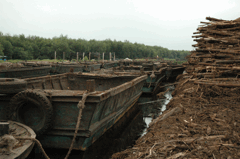 |
Two huge plantation industries are sweeping Indonesia: palm trees used to make oil, and acacia trees used to make paper. But most of the land left for plantations in the wake of deforestation is in peat forests -- land with the highest carbon content in the world. Plantations on peat have helped Indonesia become the world's third biggest greenhouse gas emitter. The debate over emissions from peatlands is most acute in Riau province, Sumatra. Ingrid Lobet reports.
Transcript
CURWOOD: It's Living on Earth, I'm Steve Curwood. It’s Living on Earth, I’m Steve Curwood.
Cookies and cakes. Mayonnaise, salad oil, and cooking oil. Soap and biodiesel. Many of these products and others are made using palm oil, derived from the oil palm tree that is now farmed on a huge commercial scale, especially in the Asian tropics. The region also produces large amounts of wood for paper. Paper and palm oil have made for some lucrative enterprises, but the associated forest losses are making major contributions to climate change.
REDD—the UN plan to reduce emissions from forest destruction and degradation --was designed to find more sustainable ways for people to profit from their forest lands, but when Ingrid Lobet went to the Indonesian island of Sumatra back in 2009, she found big challenges to the promise of REDD.
LOBET: To see what drives the Indonesian economy, just get out on the road. Even before sunrise you see truck after truck, loaded with orange palm fruits. Palm oil is big business around the world – for cooking oil, detergent and fuel. And there are still more trucks, laden with logs, to make paper. Soon our car stops so Arman, the driver, can have a smoke.
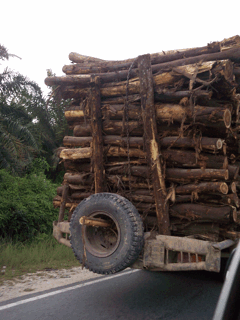
A truck carrying trees to be turned into paper.
[BIRDS SINGING; OUTDOOR SOUNDS; GIBBON IN THE BACKGROUND]
LOBET: Where we've stopped the forest is burnt away, most likely to make way for oil palm trees. In a distant stand of forest we hear gibbons. As he smokes, Arman says used to hunt them, but not anymore.
[ARMAN SPEAKING INDONESIAN]
VOICEOVER: In the forest, I came across one of these animals. I shot it four times and it fell out of the tree and leaned against it crying. It was holding a baby. It cried like a human, there were tears and it sniffed. She handed her baby to me, then sank down and died. That's when I stopped shooting animals that act like humans.
LOBET: The sound comes from way in the distance. As the trees are cut the animals are being pushed further out.
[ARMAN SPEAKING INDONESIAN]
VOICEOVER: They don’t know where to find food anymore.
LOBET: The disappearance of the forests here in Riau has been so swift. It's well documented by the environmental group WWF. But Jonotoro, who's worked here in Riau for the Forestry Ministry for 13 years, put it best:
[JONOTORO SPEAKING INDONESIAN]
VOICEOVER: Back in 1996, the forest here was still good. But after 1998, after the end of the Suharto era, it was a free for all; people just cut the forest as they pleased. There was no law enforcement. Now there’s only 20 to 30 percent of the forest left here in Riau province. That is mostly in the national parks, and even the forest there is degraded.

According to WWF, at least seventy percent of Riau’s forests have been cleared.
LOBET: Much of the vanished forest has given way to oil palm and to trees for paper. The voracious hunger for copier paper and for paper packaging, most recently in Asia, is bringing money, and foreigners to giant new paper mills in once quiet outposts.
KERR: My name is Dave Kerr, and I work for APRIL in Kerinci, Indonesia.
LOBET: APRIL or Asia Pacific Resources Limited is one of the largest pulp and paper companies in the world. And David Kerr, a boat building hobbyist who once worked in paper in eastern Canada, now directs operations here at this mill, really a small town in itself.
KERR: It’s gonna be really loud here!
REPORTER: What is this?
KERR: This is a chipping operation, you’ll see the logs going into the chipper, and disappearing!
[LOUD SOUND OF LOGS BEING CHIPPED, THEN MACHINE DIES DOWN]
KERR: Each chipper can take three or four thousand tons per day.
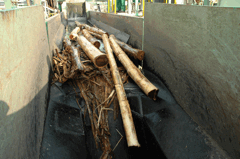
Acacia trees grown for paper are ground into chips.
[CHIPPER CHIPPING]
LOBET: Seven chipping lines swallow acacia trunks whole, and in seconds spit out thumb-sized chips of wood.
[CHIPPING MACHINE STOPS AND HUMS]
KERR: So after this the chips go to the digesters where it’s cooked, and turned into pulp.
LOBET: Pulp is the raw ingredient for paper; something the world can’t seem to get enough of. APRIL's Kerinci complex produced 800 thousand tons this year.
[VOICES AND FACTORY SOUND]
KERR: We’re about to enter Riau Paper. This is the press section and the forming area.
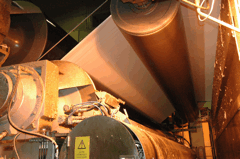
Making paper.
LOBET: Inside, the wet paper is squeezed between giant rollers, then dried, starched, and at nearly a mile a minute, crisp white paper spins onto enormous spools that each weigh more than twenty pickup trucks.
[FACTORY SOUNDS]
LOBET: The process is so fast it’s dizzying, and so loud and hot, APRIL employees monitor progress from an air-conditioned control room. They’re looking for tears, or breaks in the giant sheets.
KERR: A good day one or two breaks per day – a bad day, sometimes as much as ten.
LOBET: Does it run 24-seven?
KERR: 24-seven, 365. The only time we stop is for maintenance and that's usually measured in hours up to 12.
[SOUND OF PAPER CUTTER; STRAPPING MACHINE]
LOBET: The sheets are cut and stacked, then it's on to a printer or copier, maybe near you. But this hunger for paper and palm oil, and the forest felling that goes with it, is overwhelming even Indonesia's vast forests. So as the country pursues development, and the plantations expand, they are spreading over a very special landscape – tropical peat land.
[SOUND OF WALKING OVER DRY ORGANIC GROUND COVER]
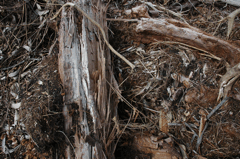
When peat forest is drained and cleared, the undecomposed plant matter in its soil is revealed.
LOBET: And the ground is a mix of acacia branches, bark, and tree material that is part of this dark brown and black peat soil. This open field was once a tropical peat land forest, a landscape unfamiliar to most Americans. Intact, it was soupy or spongy, hard to walk through. Peat forms when the water table is at ground level – or even higher. Submerged, without air, plant material doesn't decompose; it just gets compacted – into a treasure trove of stored carbon. Left alone for millions of years, it would turn into coal. But if you drain away the water by cutting canals or ditches, tropical peat lands dry out and their vast carbon stores escape into the atmosphere.
[DRY WALKING SOUND]
LOBET: In this field, a crop of pulpwood trees has just been harvested, and a new one is being planted.
BATHGATE: My name is John Bathgate. I’m a forester with a PhD in forestry. My title at the moment is plantation best practices manager.
LOBET: Bathgate is an outdoorsy New Zealander who spent ten months living in the forest among illegal tree cutters. Indonesia has vast peatlands. This island alone, Sumatra, stores more carbon in peat than is emitted globally by human activities in a year. Now much of the peat, like what we're walking on, is drained and emitting carbon at a furious rate. Many environmentalists blame plantations like this one. But, Bathgate says his company is not to blame.
BATHGATE: Just over here where these bigger trees are there is a small river. This river has been used probably for centuries or longer by local people, for fishing and hunting and gathering, and more recently for taking out timber for sale. So this land here has had quite a history of degradation and what we would call abuse – or at least not professional, high-tech development.
LOBET: When APRIL planted its first crop of pulp trees on this land he says, it was already barren. Villagers, he says, had already hacked canals into the swamp, both to float out trees they cut, and to plant crops.
BATHGATE: If, before APRIL came, this was virgin forest with the water table at the surface, then yes, we’ve got a lot to answer for. But it was like this over here. It was already – had quite a lot of illegal logging, small drains through here.

Just weeks after clearing a crop of acacia trees for paper, workers plant new seedlings.
LOBET: Today contract workers wielding heavy tampers pound the ground into flat spaces for new seedlings. I lean down close to capture the sound as the tool hits the ground, but there is virtually none; the peat absorbs it.
[FAINT SOUND OF TAMPER HITTING PEAT]
LOBET: The peat is spongy; it gives by two or three inches every time this man puts his foot down.
[SOUND OF POUNDING]
LOBET: These workers are planting seedlings of acacia, the species favored by this industry. That's because acacia grows fast – an inch a day. It sounds incredible, but in this climate, John Bathgate says these trees can be harvested for paper in just five years.
BATHGATE: So it's absolutely fantastic growth. Coupled that with that there’s high rainfall here – nearly 3,000 millimeters a year – and the fact that peat is like a big sponge absorbing and holding the moisture. So moisture for growth is available all year round. As well as that, it’s a very fine fiber for growing very soft, high quality writing paper.

APRIL’s Pelalawan nursery ships out 150,000 seedlings per day.
LOBET: And if that weren't enough to explain why the paper industry loves these trees, peat soils are quite acidic, below a pH of four. So acacia grows this fast, even with its roots marinating in the equivalent of grapefruit juice.
[MECHANICAL SOUND OF CRANE]
LOBET: On a big bare spot in this sea of paper trees, the giant claw of a Hitachi excavator grabs skinny logs out of a metal boat.
[CRANE SOUND CONTINUES]
LOBET: The cut logs floated in from the far reaches of the plantation on a canal, one of hundreds the industry carves into the peat. These canals cause carbon release, but in what's becoming a high stakes game of competing carbon claims, Bathgate says APRIL's acacia plantations actually reduce carbon emissions overall.
BATHGATE: Absolutely. What we're saying for the peat lands: we turn it from a large emitter to a less large emitter. There will still be some net emissions. On peatland, on average, we are reducing the emissions by something in the order of 50 percent.
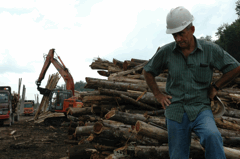
Forester John Bathgate with acacia logs barged by canal from elsewhere on the plantation. Next they'll be trucked to the mill.
LOBET: The company claims it cuts emissions by preventing fire and by setting aside 35 percent of its concessions, where forest is allowed to grow back with the water level high.
In Bathgate's view, the paper business is less harmful than the death by a thousand cuts of poor people, felling and burning the forest to plant their rice and rubber trees.
BATHGATE: I'm absolutely 100 percent convinced that leaving it to continue to degrade and leaving it for other parties to continue to degrade – it could get worse.
LOBET: But many peatland experts don't share this benign view of the plantations spreading across Indonesia. Marcel Silvius is a tropical soils expert in the Netherlands. He's lived in Indonesia, speaks the language, and was among the first scientists to point out peat's importance for carbon storage.
SILVIUS: A lot of the peat swamp forests in Indonesia are degraded. I would say about 90 percent of the peat swamp forests are degraded at the moment in Indonesian – in western Indonesia. But that doesn't mean you then have a license to go on with and even to increase the degradation by putting plantations in place of the remaining natural forest.
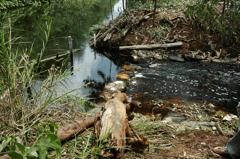
A manmade canal and dam. Water levels in acacia plantations must be carefully controlled to maximize yield.
LOBET: Silvius says APRIL's claim that plantations benefit the level of carbon in the atmosphere is just not credible. The acacia trees, he says, require at least the first two feet of peat soil to be drained, and that is not sustainable for a peat ecosystem.
SILVIUS: Peat is a soil that is consisting of organic carbon that is accumulated by the falling of leaves and decay of roots and tree trunks over thousands of years because of the waterlogged situation. And that carbon will only remain in the soil when the water levels in the area remain high. And what plantations do is they actually take the water out. And when you remove the water, the carbon will go up in the air. Because the soil carbon will react with oxygen of the air and becomes carbon dioxide, a greenhouse gas, so it warms up the earth.
LOBET: Silvius' organization, Wetlands International, estimates that in the 1990s alone, Sumatra lost 18 percent of the carbon in its soil. And when, after years, peatlands have finally given off their carbon, the damage isn't over.
SILVIUS: When the water is drained out of the peat, the soil will subside; it will become lower and lower. And then you get increased floods. And in the coastal peat swamps of Indonesia, you can get saltwater intrusion, which means that, in effect, you will render an area totally unproductive after perhaps a period of 30 to 50 years.
LOBET: In place of plantations, Silvius offers a different prescription for damaged peatlands: restore them. And that takes us to perhaps Indonesia's ground zero for forest carbon and the international money that could help keep it in the ground: a giant lowland peat storehouse known as the Kampar peninsula.
[SOUND OF GENERATOR; HAMMERING ON WOOD]
LOBET: Recently the group Greenpeace constructed a "Climate Defenders Camp," complete with kitchens, solar electricity and bunks for volunteers on one corner of this forested stretch, in hope of attracting world attention.

Greenpeace activists set up camp.
[SOUND OF SAWING]
LOBET: People from the villages nearby filled a new outdoor meeting room for the opening of the activist camp.
YASHWANT: [OVER P.A. SYSTEM] At a very critical time, all of us are sitting in a very important place.
[WOMAN TRANSLATES INTO INDONESIAN OVER P.A.]
YASHWANT: Protection of Kampar peninsula is not only important for the people who live around here or for the biodiversity, but it is also important to stabilize global climate.
[WOMAN TRANSLATES INTO INDONESIAN OVER P.A.]
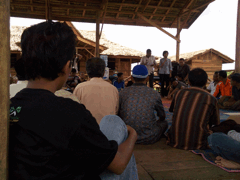
LOBET: This peat-rich peninsula perfectly illustrates the maneuvering taking place in forested parts of the globe, as players try to guarantee that global investments in forest carbon flow to them. Kampar consists of one giant dome of sodden peat. It's a rainwater-driven landscape with ground and belowground flows from the center to the periphery, into the ocean. APRIL's John Bathgate says plantations on the periphery can protect those all-important deep carbon stores in the middle.
BATHGATE: So we are one of the players that have done quite a lot of the work at looking at the value of the core and how the core could be fully protected, because that needs to happen.
LOBET: APRIL calculates plantations will reduce emissions in the periphery, or what it calls the Kampar Ring, and it hopes to market credits for that saved carbon directly to international investors.
BATHGATE: The figure we come up with is about – is a reduction of about two point six million tons of CO2 per hectare per year. At a conservative value of ten dollars – that is 26 million dollars a year to actually then be fed back into protecting the core of the Kampar peninsula, which is where the really large carbon is, and providing benefits for stakeholders. It's not just our carbon, I mean the carbon belongs to the people of Indonesia – the Ministry of Forestry of Indonesia has a stake, local communities have stake.
LOBET: But peat expert Marcel Silvius has a different idea that he says would raise more money: let the government sell carbon credits through the emerging UN forest finance system, and with the proceeds employ local people in ecology – blocking up the old illegal logging canals and restoring Kampar's damaged outer periphery.
SILVIUS: Why not just immediately restore the hydrology of the area and with that stop the soil emissions, and then plant indigenous tree species, which do not require drainage? And actually you can make a lot of money on it. From an area like Kampar it is easy to get something like 30 to 50 million dollars per year in carbon credit benefits. So we are really looking at a new and massive opportunity for conservation.
LOBET: In order to make this plan work for Kampar, the Indonesian government would need to be on board. That's part of why Greenpeace opened its camp. But after activists chained themselves to an APRIL excavator recently, many of the foreign activists were deported. Still Greenpeace workers like Bustar Maitar managed to get out the message to the newly re-elected Indonesian president, Susilo Bambang Yudhoyono, known here as SBY.
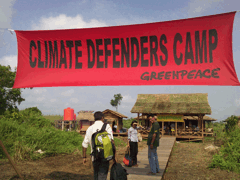
MAITAR: So if the SBY want to make a difference he supposed to be starting from here, to protect the peatland forest. Because you know 40 percent of the greenhouse gases in Indonesia is coming from the peatland destruction. So this is very important – SBY starting his commitment to reduce the greenhouse gases and starting from here. He can make a change, starting from here, in Kampar peninsula.
CURWOOD: Greenpeace worker Bustar Maitar ending that report from Ingrid Lobet in Sumatra’s Kampar Peninsula.
Links
Recent Scientific Paper on Peat Emissions
Asia Pacific Resources International Limited
Peat Experts Wetlands International
Environmental Collaborative Group in Riau Eyes on the Forest
Living on Earth wants to hear from you!
Living on Earth
62 Calef Highway, Suite 212
Lee, NH 03861
Telephone: 617-287-4121
E-mail: comments@loe.org
Newsletter [Click here]
Donate to Living on Earth!
Living on Earth is an independent media program and relies entirely on contributions from listeners and institutions supporting public service. Please donate now to preserve an independent environmental voice.
NewsletterLiving on Earth offers a weekly delivery of the show's rundown to your mailbox. Sign up for our newsletter today!
 Sailors For The Sea: Be the change you want to sea.
Sailors For The Sea: Be the change you want to sea.
 The Grantham Foundation for the Protection of the Environment: Committed to protecting and improving the health of the global environment.
The Grantham Foundation for the Protection of the Environment: Committed to protecting and improving the health of the global environment.
 Contribute to Living on Earth and receive, as our gift to you, an archival print of one of Mark Seth Lender's extraordinary wildlife photographs. Follow the link to see Mark's current collection of photographs.
Contribute to Living on Earth and receive, as our gift to you, an archival print of one of Mark Seth Lender's extraordinary wildlife photographs. Follow the link to see Mark's current collection of photographs.
 Buy a signed copy of Mark Seth Lender's book Smeagull the Seagull & support Living on Earth
Buy a signed copy of Mark Seth Lender's book Smeagull the Seagull & support Living on Earth

